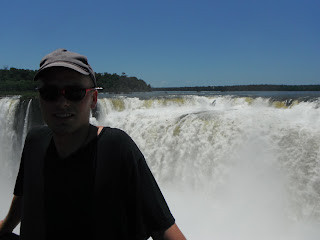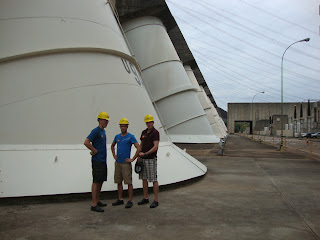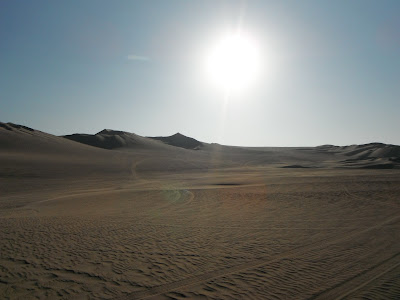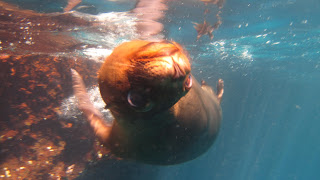One of my favourite things about traveling is learning about
how people live in other parts of the world. Some cultures value certain
aspects of life more highly than others, and find different ways of
accomplishing the same goals. As they say, there is more than one way to skin a
cat. Or as Richard sometimes says “The Chinese know 101 ways to wok a dog”.
Yesterday we left Ecuador behind, and right now I am sitting
on a bus in the Northern part of Peru driving towards the country’s capital
city of Lima. Having just finished spending a month in Peru, I am now
reflecting on some of the things I noticed about their culture that intrigued
me, or was distinctly different from society in Canada.
Before I start, I want to quickly mention how AMAZING the
bus we’re riding on is. First of all, the seats have more leg room and tilt
back farther than the typical Greyhound bus – not to mention have individual
leg rests. They just served us a hot dinner that was delicious: chicken and
rice. They’ve brought drinks around twice and are showing movies for us with
the sound on quiet; just in case I’d rather listen to my ipod (which I did).
Each person is provided with a pillow and blanket upon entry into the bus, and
there is onboard Wi-Fi! I’m actually posting this to the internet from the bus.
The bus ride is 15 hours overnight, and it costs 85 Peruvian Nuevo Sols, or
around $30 – not bad value.
One other quick update before I begin that unfortunately is
not so good news: Jordan had a bunch of his stuff stolen at the Peruvian border
including all his entertainment devices (ipods and such) and a fair chunk of
cash. It’s definitely left a dark cloud over the group for today, and is
causing us to be even more careful with our belongings.
But I digress, back to the main point of the article. From
what I’ve seen, people in Ecuador seem to value above all else family and
community. These values appear to permeate many areas of their life: work,
leisure, and just overall how they spend their time.
Leisure
A great example of how important family is to Ecuadorians is
when we were on a bus between Otovalo and Quito, after we’d just
finished checking out the Otovalo market and the Cockfight. On the bus James
was sitting beside a woman and her daughter, and was trying his best to make
pleasant conversation with them in Spanish. These people, like most in mainland
Ecuador did not look wealthy – and just taking the time and money to bus from Otovalo
to Quito would be quite an investment for them. When James asked them why they
were going to Quito, they said they were bussing there to celebrate a fiesta that
was being put on for the woman’s uncle’s birthday. I don’t think I’ve ever been
to a birthday put on for one of my aunts or uncles, never mind taken a 4 hour
bus ride just to attend.

The impression I have received from people in Ecuador is
that birthdays and other holidays are times for large family gatherings; and
these fiestas form a key part of the people’s social lives and activities. There
are at least a couple times when we were walking down streets and would see
community halls rented out for some sort of fiesta or family gathering.
Work
One of the most surprising things I’ve found in Ecuador is
the very minimal impact big business seems to have had on the country. I could
count on one hand the number of fast food chains I’ve seen, and I don’t think I’ve
run into even one Starbucks. Business in Ecuador is almost exclusively small
businesses: mom and pop shops.
I’ve noticed a few implications of this phenomenon. First,
there are some AMAZING salesmen here. I think when there are not many big
businesses to work for, people are forced to sell products themselves. And with
all the practise they have, some people get really really good. For instance,
on one bus we were riding a man came on and started talking really loudly in
Spanish. I have no idea what he was saying, but he kept his spiel going for
about 20 minutes, and finally at the end started placing useless trinkets and
fake jewellery in people’s hands. By the time he got off the bus, he had sold a
useless trinket to over half the people on our bus! I was blown away.
But perhaps more interestingly, the lack of big-box companies
forces Ecuadorians to be mini-entrepreneurs, and puts them all in an ownership
position of their income. One result of this is that we constantly saw people
bringing their children to work with them. I saw children “working” at fruit
stands, restaurants, markets, travel agencies, hostels, you name it. Not that
it is child labour, but rather the whole family tends to live at the place of
work. My guess is that most people can’t afford to hire day-care workers to
care for their children while they run their business, so instead they just
bring their kids with them.
 |
| Sugar Cane ready for cutting. Lots of the people in Mindo processed sugar cane and turned it into sweet treats. |
Spare Time
Not surprisingly, the activity of choice for Ecuadorians is
soccer. All the children seem to play it, and days for kids are spent at the
soccer field once school is done. James and Jordan and I joined the kids in a
soccer game recently in Galapagos, and found their soccer skills quite
impressive.
For adults, however, there is a different game that
dominates the culture: soccer volleyball. The first time we encountered this
sport was in Ecuador’s capital city of Quito. We were walking through the park,
when we saw a huge crowd of probably 100 people all standing around a
volleyball court. Naturally, we were curious as to what high calibre volleyball
players must have been attracting all the attention. After watching a few
rallies it didn’t seem like the players were any better than we probably were.
And at that, they kept on cheating by “throwing” the volleyball instead of
volleying it properly.
We’ve encountered very similar games going on all over the
country, all with equally large groups of on-lookers. Our Sherlock skills have
concluded that this is not an anomaly – this is a legitimate game that is not
quite volleyball but similar.
Unfortunately the games were a little rich for our blood. If you want to play,
you have to put up at least a couple hundred dollars, and the winners for the
day go home with most of the bounty. For Ecuadorians its not just a sport, its
a form of gambling as well.
Overall Take
I think there are alot of really good things about the
culture in Ecuador, and their sense of community and family commitment seems
great. However, there is one odd thing about people in Ecuador: they rarely
ever smile.
People seem to avoid eye contact, and for the most part don’t make
jokes or show a positive interest in you and your life. I don’t think its
something Ecuadorians hold against white people, or Americans, or anything like
that. I think its part of their culture. For that reason, I don’t think I’d
want to live in Ecuador for significant amounts of time.
Crossing the border to Peru really emphasizes this downside to Ecuador;
Peruvians are very friendly, have big smiles, and are very welcoming to strangers.
Tomorrow is Jame’s birthday, so hopefully we’ll be able to
find some cake for him!



















































